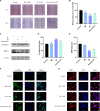Late-stage modification of complex drug: Base-controlled Pd-catalyzed regioselective synthesis and bioactivity of arylated osimertinibs
- PMID: 38457511
- PMCID: PMC10923520
- DOI: 10.1126/sciadv.adl0026
Late-stage modification of complex drug: Base-controlled Pd-catalyzed regioselective synthesis and bioactivity of arylated osimertinibs
Abstract
Achieving regioselective synthesis in complex molecules with multiple reactive sites remains a tremendous challenge in synthetic chemistry. Regiodivergent palladium-catalyzed C─H arylation of complex antitumor drug osimertinib with various aryl bromides via the late-stage functionalization strategy was demonstrated here. This reaction displayed a switch in regioselectivity under complete base control. Potassium carbonate (K2CO3) promoted the arylation of acrylamide terminal C(sp2)-H, affording 34 derivatives. Conversely, sodium tert-butoxide (t-BuONa) mediated the aryl C(sp2)-H arylation of the indole C2 position, providing 27 derivatives. The derivative 3r containing a 3-fluorophenyl group at the indole C2 position demonstrated similar inhibition of EGFRT790M/L858R and superior antiproliferative activity in H1975 cells compared to osimertinib, as well as similar antiproliferative activity in A549 cells and antitumor efficacy in xenograft mouse model bearing H1975 cells. This approach provides a "one substrate-multi reactions-multiple products" strategy for the structural modification of complex drug molecules, creating more opportunities for the fast screening of pharmaceutical molecules.
Figures





Similar articles
-
Design, synthesis and biological evaluation of novel osimertinib derivatives as reversible EGFR kinase inhibitors.Eur J Med Chem. 2022 Aug 5;238:114492. doi: 10.1016/j.ejmech.2022.114492. Epub 2022 Jun 7. Eur J Med Chem. 2022. PMID: 35696862
-
Design, Synthesis, and Biological Evaluation of Dual Inhibitors of EGFRL858R/T790M/ACK1 to Overcome Osimertinib Resistance in Nonsmall Cell Lung Cancers.J Med Chem. 2024 Feb 22;67(4):2777-2801. doi: 10.1021/acs.jmedchem.3c01934. Epub 2024 Feb 7. J Med Chem. 2024. PMID: 38323982
-
Structural modifications on indole and pyrimidine rings of osimertinib lead to high selectivity towards L858R/T790M double mutant enzyme and potent antitumor activity.Bioorg Med Chem. 2021 Apr 15;36:116094. doi: 10.1016/j.bmc.2021.116094. Epub 2021 Feb 25. Bioorg Med Chem. 2021. PMID: 33667898
-
The impact of EGFR T790M mutation status following the development of Osimertinib resistance on the efficacy of Osimertinib in non-small cell lung cancer: A meta-analysis.Clin Respir J. 2024 Apr;18(4):e13748. doi: 10.1111/crj.13748. Clin Respir J. 2024. PMID: 38584122 Free PMC article. Review.
-
Exploring the structural activity relationship of the Osimertinib: A covalent inhibitor of double mutant EGFRL858R/T790M tyrosine kinase for the treatment of Non-Small Cell Lung Cancer (NSCLC).Bioorg Med Chem. 2024 Jul 15;109:117796. doi: 10.1016/j.bmc.2024.117796. Epub 2024 Jun 11. Bioorg Med Chem. 2024. PMID: 38879996 Review.
Cited by
-
Late-Stage N-Alkenylative Modifications of Indolic Scaffolds with Propiolates: Toward Bisconjugation and Macrocyclization.Org Lett. 2025 May 23;27(20):5081-5086. doi: 10.1021/acs.orglett.5c01162. Epub 2025 May 14. Org Lett. 2025. PMID: 40368809 Free PMC article.
-
Design, synthesis and anti-proliferative activity of 3-aryl-evodiamine derivatives.RSC Med Chem. 2025 Apr 14. doi: 10.1039/d5md00179j. Online ahead of print. RSC Med Chem. 2025. PMID: 40621061 Free PMC article.
-
Two-polarized roles of transcription factor FOSB in lung cancer progression and prognosis: dependent on p53 status.J Exp Clin Cancer Res. 2024 Aug 21;43(1):237. doi: 10.1186/s13046-024-03161-1. J Exp Clin Cancer Res. 2024. PMID: 39164746 Free PMC article.
References
-
- Bryan M. C., Dillon B., Hamann L. G., Hughes G. J., Kopach M. E., Peterson E. A., Pourashraf M., Raheem I., Richardson P., Richter D., Sneddon H. F., Sustainable practices in medicinal chemistry: Current state and future directions. J. Med. Chem. 56, 6007–6021 (2013). - PubMed
-
- Costantino L., Barlocco D., Ten years of medicinal chemistry (2005−2014) in the Journal of Medicinal Chemistry: Country of contributors, topics, and public-private partnerships. J. Med. Chem. 59, 7352–7359 (2016). - PubMed
-
- Aliagas I., Berger R., Goldberg K., Nishimura R. T., Reilly J., Richardson P., Richter D., Sherer E. C., Sparling B. A., Bryan M. C., Sustainable practices in medicinal chemistry part 2: Green by design. J. Med. Chem. 60, 5955–5968 (2017). - PubMed
-
- Wu G., Zhao T., Kang D., Zhang J., Song Y., Namasivayam V., Kongsted J., Pannecouque C., Clercq E. D., Poongavanam V., Liu X., Zhan P., Overview of recent strategic advances in medicinal chemistry. J. Med. Chem. 62, 9375–9414 (2019). - PubMed
-
- Moir M., Danon J. J., Reekie T. A., Kassiou M., An overview of late-stage functionalization in today’s drug discovery. Expert Opin. Drug Discov. 14, 1137–1149 (2019). - PubMed
Publication types
MeSH terms
Substances
LinkOut - more resources
Full Text Sources
Medical
Research Materials
Miscellaneous

